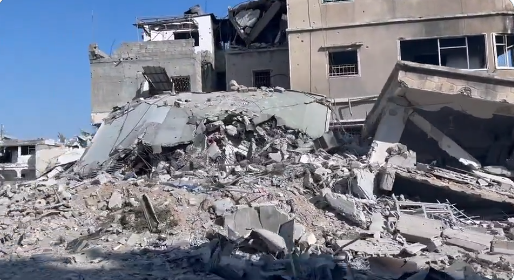A fresh round of urgent cease-fire negotiations between Israel and Hamas was set to begin on Thursday in Cairo, following on the heels of quickly-arranged talks held last week in Doha. The outcome of these discussions may soon reveal whether the optimism expressed by the White House over recent days is grounded in reality or merely hopeful thinking.
One of the most contentious issues looming over the talks is the potential withdrawal of Israeli military forces from Gaza’s southern border with Egypt, known as the Philadelphi Corridor. Reports suggested that President Biden might press Prime Minister Benjamin Netanyahu to consider this shift during their conversation on Wednesday evening. However, Netanyahu quickly dismissed a report from the Washington Post claiming he would pull back troops from the border zone, calling it “not true” on Israeli television.
U.S. and Israeli delegations started a new round of meetings in Cairo today aimed at resolving differences over a truce proposal to end more than 10 months of war between Israel and Hamas in Gaza. pic.twitter.com/N6Sx0o1pBB
— Salem News Channel (@WatchSalemNews) August 22, 2024
Netanyahu has consistently argued that maintaining control over Gaza’s southern border is crucial to prevent Hamas from smuggling weapons through Egypt. Israeli Defense Minister Yoav Gallant announced on Wednesday that Israeli forces had destroyed over 150 Hamas tunnels along the border corridor, though Egyptian officials have disputed Israeli claims that significant material support for Hamas comes via this route.
Sima Shine, an expert on Iran and former Mossad intelligence officer, suggested to CBS News that failure in the cease-fire talks could soon lead to a broader military conflict involving Israel and Hezbollah, with the potential for the United States to be drawn in as well.
The U.S., Israel’s strongest ally, has a significant military presence in the Middle East, with over 30,000 troops stationed in the region as of last year. Since Hamas launched its October 7 attack on Israel, sparking the ongoing conflict in Gaza, the U.S. has bolstered its military presence in the area even further.
‘Hamas refused to send a team for ceasefire negotiations in Cairo because additional talks would serve no purpose except to provide cover for the US and Israel,’ @MouinRabbani says of a proposal for more truce talks.
Catch the latest episode of Palestine This Week… pic.twitter.com/LQcnf4Db34
— Middle East Monitor (@MiddleEastMnt) August 16, 2024
Shine explained that Iran’s “Axis of Resistance,” which includes Hezbollah in Lebanon, Hamas in Gaza, the Houthis in Yemen, and various militias across Iraq, Afghanistan, Pakistan, and Syria, represents a significant threat. While many view Iran as Israel’s greatest security threat, Shine pointed out that Hezbollah, with its proximity to Israel and its arsenal of around 150,000 rockets and missiles, poses a more immediate danger.
A readout from the U.S. Embassy in Israel following Wednesday’s call between President Biden and Netanyahu emphasized the enhanced U.S. military presence in the region, including additional warplanes, naval destroyers, and the USS Abraham Lincoln aircraft carrier strike group, which arrived with F-35 fighter jets.
The Cairo talks are expected to continue through the weekend, with both Israel and Hamas accusing each other of undermining previous negotiations. The U.S. indicated earlier this week that Israel had agreed to a “bridging proposal” aimed at closing the remaining gaps between the demands of both sides, though some changes had been made to the original terms.
A ceasefire deal is within reach in the Gaza War, but is dangerously elusive, says U.S official.
Biden says talks in Cairo are crucial to the process, this comes after Anthony Blinken recently trip.
Israel wants to retain control of the Philadelphi Corridor. pic.twitter.com/vhbRb5oj32
— Thomas (@Thomas984634784) August 22, 2024
Hamas, meanwhile, expressed a desire to revisit a proposal from July 2 that was initially supported by the U.S. and the United Nations. The group has accused Israel of altering the terms of that proposal, and the U.S. of endorsing those changes due to a pro-Israel bias.
The health ministry in Gaza, controlled by Hamas, reported that more than 40,200 people have died as a result of Israel’s military actions, though the figures do not differentiate between combatants and civilians. In the past 24 hours alone, the ministry recorded 42 deaths and 163 injuries.
Hamas’s attack on October 7 resulted in the deaths of approximately 1,200 Israelis and the capture of around 250 hostages, 80 of whom are believed to still be alive in Gaza.
Major Points
- Urgent cease-fire talks between Israel and Hamas are set to take place in Cairo, following recent discussions in Doha, with the outcome crucial to the conflict’s trajectory.
- One key issue is the potential withdrawal of Israeli forces from Gaza’s southern border with Egypt, though Prime Minister Netanyahu has denied plans to pull back troops.
- Israeli Defense Minister Gallant reported the destruction of over 150 Hamas tunnels near the border, while Egypt disputes the extent of support for Hamas through this route.
- The U.S. has increased its military presence in the Middle East, with over 30,000 troops and additional naval and air assets, amid concerns about broader conflict involving Hezbollah and Iran.
- The talks, expected to continue through the weekend, follow a “bridging proposal” by the U.S. aimed at closing gaps between Israel and Hamas, as both sides blame each other for undermining previous negotiations.
Susan Guglielmo – Reprinted with permission of Whatfinger News


